What Is The State Animal Of New Hampshire
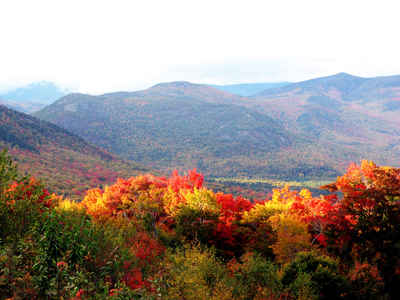
State Animals
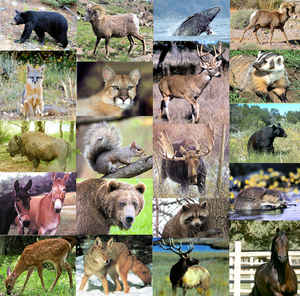
New Hampshire Symbols

New Hampshire Symbols
Amphibian, Animal, Beverage, Bird, Butterfly, Canis familiaris, Emblem, Flag, Flower, Fish (Freshwater), Fish (Saltwater Game), Fruit, Gem, Honorary Songs, Insect, Language, Mineral, Motto, New Hampshire Native, Nicknames, Quarter, Rock, Seal, Song, Sport, Tartan, Tree, Vegetable, Wildcat, Wildflower
State Symbols Listing
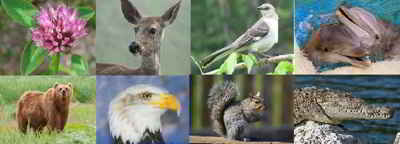
- State Resources
- » 50 States
- » State Symbols
- » Mammals
New Hampshire State Animal
White-tailed Deer
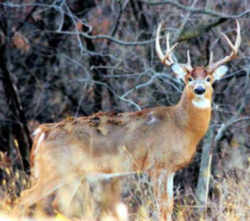
(Odocoileus virginianus)
Adopted in 1983.
The white tail deer, (Odocoileus virginianus,) likewise known every bit the Virginia deer was named the land beast in 1983. The deer is common to North America. The white tail deer is an fauna of incredible beauty and ability, the white-tailed deer are able to run with speed up to 40 miles per hour, spring 9 pes fences, and in the water, swim up to 13 miles per hour. The white underside of the deer's tail waves, thus the proper noun white-tail when running and is flashed as a alert when danger is sensed. Both native Americans and settlers relied on the white-tailed deer for buckskin and food.
New Hampshire Revised Statutes Annotated (RSA) 3:12
States that have named the White-tailed deer (Odocoileus virginianus) as their official state mammal and/or animate being:
Arkansas | Illinois | Michigan
Mississippi | Nebraska | New Hampshire
Ohio | Oklahoma | Pennsylvania | South Carolina | Wisconsin
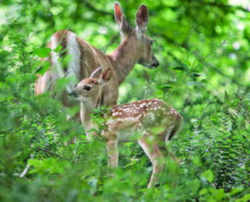
This lovely animate being has played a significant office in New Hampshire'due south history. When Europeans beginning settled in New Hampshire, the white-tailed deer was in great supply. It was already an important nutrient for the Native Peoples, along with providing clothing, and tools (from their antlers).
The white-tailed deer has a specific nutrition of leaves, grass, buds, berries, wild grapes, bark, acorns, soft twigs, fungi, apples, clover, and farm crops. Adult deer need six to eight pounds of food per 100/lbs of trunk weight DAILY.
Adult males are chosen bucks, stags, harts or bulls; females are called does, hinds and cows. The young members are called fawns or calves.
Mutual Names
white-tailed deer; whitetail deer; Columbian white-tailed deer; Primal deer; Coues deer; Texas white-tailed deer; sandhill deer; common deer; jumping deer; flag-tailed deer; bannertail; long-tailed deer; Virginia white-tailed deer; Virginia deer
Characteristics of the White-tail
Physical Characteristics
Head and body length is 150 to 200 cm, tail length is ten to 28 cm, and height at the shoulders is between eighty and 100 cm.
Odocoileus virginianus dorsal coloration differs in shading locally, seasonally, and among subspecies; nonetheless in full general it is grayer in the winter and redder in the summer. White fur is located in a band backside the olfactory organ, in circles around the eyes, inside the ears, over the chin and throat, on the upper insides of the legs and beneath the tail. Whitetail deer take scent glands betwixt the ii parts of the hoof on all four feet, metatarsal glands on the exterior of each hind leg, and a larger tarsal gland on the within of each hind leg at the hock. Scent from these glands is used for intra-species communication and secretions get specially strong during the rutting season. Males possess antlers which are shed from Jan to March and grow out once again in April or May, losing their velvet in August or September. At nascence, fawns are spotted with white in coloration and weight between one.5 and 2.v kg. Their coats become grayish lose their spots past their kickoff wintertime. Whitetail deer have adept eyesight and acute hearing, merely depend mainly on their sense of smell to find danger.
Food Habits
Whitetail deer feed on a multifariousness of vegetation, depending on what is available in their habitat. In eastern forests, buds and twigs of maple, sassafras, poplar, aspen and birch (to proper noun a few) are consumed, besides as many shrubs. In desert areas, plants such as huajillo castor, yucca, prickly pear cactus, comal, ratama and various tough shrubs may be the main components of a whitetail's nutrition. Conifers are often utilized in winter when other foods are scarce. Whitetail deer are crepuscular, feeding mainly from before dawn until several hours afterwards, and once more from late afternoon until sunset.
Reproduction
About whitetail deer (particularly males) mate in their second year, although some females occasionally mate equally young every bit seven months. Bucks are polygamous although they may class an attachment and stay with a single doe for several days or even weeks until she reaches oestrus. Does are seasonally polyoestrous and usually come up into estrus in November for a brusque twenty-four hour menstruum. If a doe is not mated, a second rut occurs approximately 28 days later. Mating occurs from October to Dec and gestation is approximately six and a half months. In her outset yr of breeding, a female generally has one fawn, merely ii per litter (occasionally 3 or 4) are built-in in subsequent years. Fawns are able to walk at birth and nibble on vegetation simply a few days afterward. They are weaned at approximately six weeks. Life span in the wild is 10 years, only whitetail deer have lived up to 20 years in captivity.
Behavior
Whitetail deer are the most nervous and shy of our deer. They moving ridge their tails characteristically from side to side when they are startled and fleeing. They are extremely active and may bound at speeds of up to thirty miles per 60 minutes through tangled terrain in a forest. Whitetail deer are too good swimmers and often enter big streams and lakes to escape predators or insects or to visit islands. Their habitation ranges are generally small-scale, often a square kilometer or less. Whitetail deer practise not drift to a wintertime range but k upward in their own territories during heavy snow. They are notorious for continually using the aforementioned pathways when foraging, but volition not bed downward during the day in areas that they take used previously.
Whitetail deer are generally considered solitary, particularly in summer. The basic social unit of measurement is a female person and her fawns, although does have been observed to graze together in herds of upward to hundreds of individuals. Females by and large follow their mothers for nearly two years, but males get out the grouping inside the starting time twelvemonth. Bucks may form transient groups of two-4 in the summer, but these disband prior to the mating season. Males begin rutting as early as September, and at this point go entirely preoccupied with obtaining matings. They practice non guard harems (as with elk) merely rather fight each other individually, clashing antlers to gain access to a particular female.
Whitetail does are painstakingly careful to keep their offspring hidden from predators. When foraging, females exit their offspring in dense vegetation for about four hours at a fourth dimension. While waiting for the female to return, fawns lay flat on the footing with their necks outstretched, well inconspicuous against the woods floor. Fawns withhold their feces and urine until the mother arrives, at which point she ingests whatsoever the fawn voids to deny predators any sign of the fawn.
Whitetail deer are not especially vocal, although young fawns squeal on occasion. Injured deer utter a startlingly loud "blatt" or bark. Whistles or snorts of disturbed whitetails are the nearly commonly heard sounds.
Habitat
Whitetail deer are able to survive in a variety of terrestrial habitats, from the big woods of northern Maine to the deep saw grass and hammock swamps of Florida. They likewise inhabit farmlands, brushy areas and such desolate areas of the due west such equally the cactus and thorn brush deserts of southern Texas and Mexico. Ideal whitetail deer habitat would incorporate dumbo thickets (in which to hide and motion almost) and edges (which furnish nutrient).
In that location are 16 subspecies of white-tailed deer in North America. Subspecies are distinguished past geographic location, body size, coloration, antler growth, and physiological, biochemical, and behavioral differences .
Scientific name
The genus proper name Odocoileus is from the Greek words odon (tooth) and koilos (hollow) or "hollow tooth," in reference to the depressions in the crown of the molar teeth. The Latinized species name virginianus (of Virginia) refers to the country from which the species was offset collected and described.
New Hampshire Police
The law designating the white tail deer as the official New Hampshire land animal is establish in the New Hampshire Statutes, Title 1, Affiliate 3, Department 3:12.
TITLE I THE STATE AND ITS Regime
Affiliate 3 STATE EMBLEMS, FLAG, ETC.
SECTION 3:12
three:12 State Brute. --The white tail deer is hereby designated every bit the official country beast of New Hampshire.
Source. 1983, 190:2, eff. Aug. xiv, 1983.
Taxonomic Hierarchy: White-tailed Deer
Kingdom: Animalia
Phylum: Chordata
Class: Mammalia
Guild: Artiodactyla
Family: Cervidae
Subfamily: Capreolinae
Genus: Odocoileus
Species: O. virginianus
State Mammals
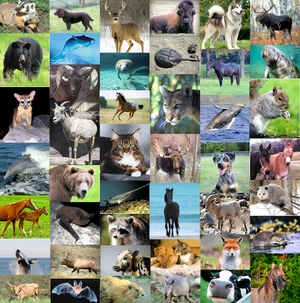
Mammals are vertebrates (backboned animals) that feed their young on mother's milk.
Source: https://www.ereferencedesk.com/resources/state-mammal/new-hampshire-animal.html
Posted by: sohimpt1956.blogspot.com

0 Response to "What Is The State Animal Of New Hampshire"
Post a Comment